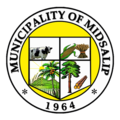Midsalip Last updated September 01, 2025 Municipality in Zamboanga del Sur, Philippines
Municipality in Zamboanga Peninsula, Philippines
Midsalip , officially the Municipality of Midsalip (Cebuano : Lungsod sa Midsalip Subanen : Benwa Midsalip ; Chavacano : Municipalidad de Midsalip ; Tagalog : Bayan ng Midsalip municipality in the province of Zamboanga del Sur , Philippines . According to the 2020 census, it has a population of 33,711 people. [ 5]
Etymology The town's name is from a Subanen word,"Migsalip " which means "to collect" or "accumulate".
History Midsalip was formed as a municipality out of 21 barrios of the Municipality of Ramon Magsaysay and 6 barrios of the municipality of Dumingag on September 9, 1964, by virtue of Executive Order Number 94 signed by President Diosdado Macapagal . [ 6] This did not last long, however, as it was dissolved on February 26, 1966, due to a Supreme Court decision regarding the legality of the funds disbursed by the municipal treasurer. As a result, Midsalip was reverted to barrio status. It was not until May 8, 1967, when the Republic Act No. 4871 was passed when Midsalip became a regular municipality again. [ 7]
Geography Climate Climate data for Midsalip, Zamboanga del Sur Month Jan Feb Mar Apr May Jun Jul Aug Sep Oct Nov Dec Year Mean daily maximum °C (°F) 25 25 26 26 25 24 24 24 24 24 24 25 25 Mean daily minimum °C (°F) 17 17 18 18 19 19 18 18 18 19 18 18 18 Average precipitation mm (inches) 48 44 56 56 112 135 124 124 115 134 90 56 1,094 Average rainy days 13.0 11.7 15.6 18.1 25.6 25.7 25.2 24.1 23.8 26.1 22.3 16.5 247.7 Source: Meteoblue [ 8]
Barangay captain names Midsalip is politically subdivided into 33 barangays . Each barangay consists of puroks while some have sitios .
Bacahan Balonai Bibilop Buloron Cabaloran Canipay Norte Canipay Sur Cumarom Dakayakan Duelic Dumalinao Ecuan Golictop Guinabot Guitalos Guma Kahayagan Licuro-an Lumpunid Matalang New Katipunan New Unidos Palili Pawan Pili Pisompongan Piwan Poblacion A Poblacion B Sigapod Timbaboy Tulbong Tuluan Demographics Population census of Midsalip Year ±% p.a. 1970 17,397 — 1975 20,927 +3.77% 1980 24,624 +3.31% 1990 22,891 −0.73% 1995 25,258 +1.86% 2000 28,909 +2.94% 2007 30,772 +0.87% 2010 31,467 +0.82% 2015 32,075 +0.37% 2020 33,711 +1.05% 2024 35,643 +1.35% Source: Philippine Statistics Authority [ 9] [ 10] [ 11] [ 12] [ 13]
Economy Poverty incidence of Midsalip
References ↑ Municipality of Midsalip | (DILG) ↑ "2015 Census of Population, Report No. 3 – Population, Land Area, and Population Density" (PDF) . Philippine Statistics Authority . Quezon City, Philippines. August 2016. ISSN 0117-1453 . Archived (PDF) from the original on May 25, 2021. Retrieved July 16, 2021 . ↑ "2024 Census of Population (POPCEN) Population Counts Declared Official by the President" . 2024 Philippine census . Philippine Statistics Authority. July 17, 2025. Retrieved July 18, 2025 . ↑ "PSA Releases the 2021 City and Municipal Level Poverty Estimates" . Philippine Statistics Authority. April 2, 2024. Retrieved April 28, 2024 . ↑ "2024 Census of Population (POPCEN) Population Counts Declared Official by the President" . 2024 Philippine census . Philippine Statistics Authority. July 17, 2025. Retrieved July 18, 2025 . ↑ "Executive Order No. 94: Creating the Municipality of Midsalip in the Province of Zamboanga del Sur" . Official Gazette of the Republic of the Philippines . Manila, Philippines: Presidential Communications Development and Strategic Planning Office. September 4, 1964. Retrieved July 24, 2014 . ↑ "Republic Act No. 4871 - An Act Creating the Municipality of Midsalip in the Province of Zamboanga del Sur" . Philippine Laws, Statutes & Codes . Chan Robles Virtual Law Library. May 8, 1967. Retrieved July 24, 2014 . ↑ "Midsalip: Average Temperatures and Rainfall" . Meteoblue. Retrieved May 1, 2020 . ↑ "2024 Census of Population (POPCEN) Population Counts Declared Official by the President" . 2024 Philippine census . Philippine Statistics Authority. July 17, 2025. Retrieved July 18, 2025 . ↑ Census of Population (2015). "Region IX (Zamboanga Peninsula)" . Total Population by Province, City, Municipality and Barangay . Philippine Statistics Authority . Retrieved June 20, 2016 . ↑ Census of Population and Housing (2010). "Region IX (Zamboanga Peninsula)" (PDF) . Total Population by Province, City, Municipality and Barangay . National Statistics Office . Retrieved June 29, 2016 . ↑ Censuses of Population (1903–2007). "Region IX (Zamboanga Peninsula)" . Table 1. Population Enumerated in Various Censuses by Province/Highly Urbanized City: 1903 to 2007 National Statistics Office . ↑ "Province of" . Municipality Population Data . Local Water Utilities Administration Research Division. Retrieved December 17, 2016 . ↑ "Poverty incidence (PI):" . Philippine Statistics Authority. Retrieved December 28, 2020 . ↑ "Estimation of Local Poverty in the Philippines" (PDF) . Philippine Statistics Authority. November 29, 2005. ↑ "2003 City and Municipal Level Poverty Estimates" (PDF) . Philippine Statistics Authority. March 23, 2009. ↑ "City and Municipal Level Poverty Estimates; 2006 and 2009" (PDF) . Philippine Statistics Authority. August 3, 2012. ↑ "2012 Municipal and City Level Poverty Estimates" (PDF) . Philippine Statistics Authority. May 31, 2016. ↑ "Municipal and City Level Small Area Poverty Estimates; 2009, 2012 and 2015" . Philippine Statistics Authority. July 10, 2019. ↑ "PSA Releases the 2018 Municipal and City Level Poverty Estimates" . Philippine Statistics Authority. December 15, 2021. Retrieved January 22, 2022 . ↑ "PSA Releases the 2021 City and Municipal Level Poverty Estimates" . Philippine Statistics Authority. April 2, 2024. Retrieved April 28, 2024 . External links
Places adjacent to Midsalip
This page is based on this
Wikipedia article Text is available under the
CC BY-SA 4.0 license; additional terms may apply.
Images, videos and audio are available under their respective licenses.




